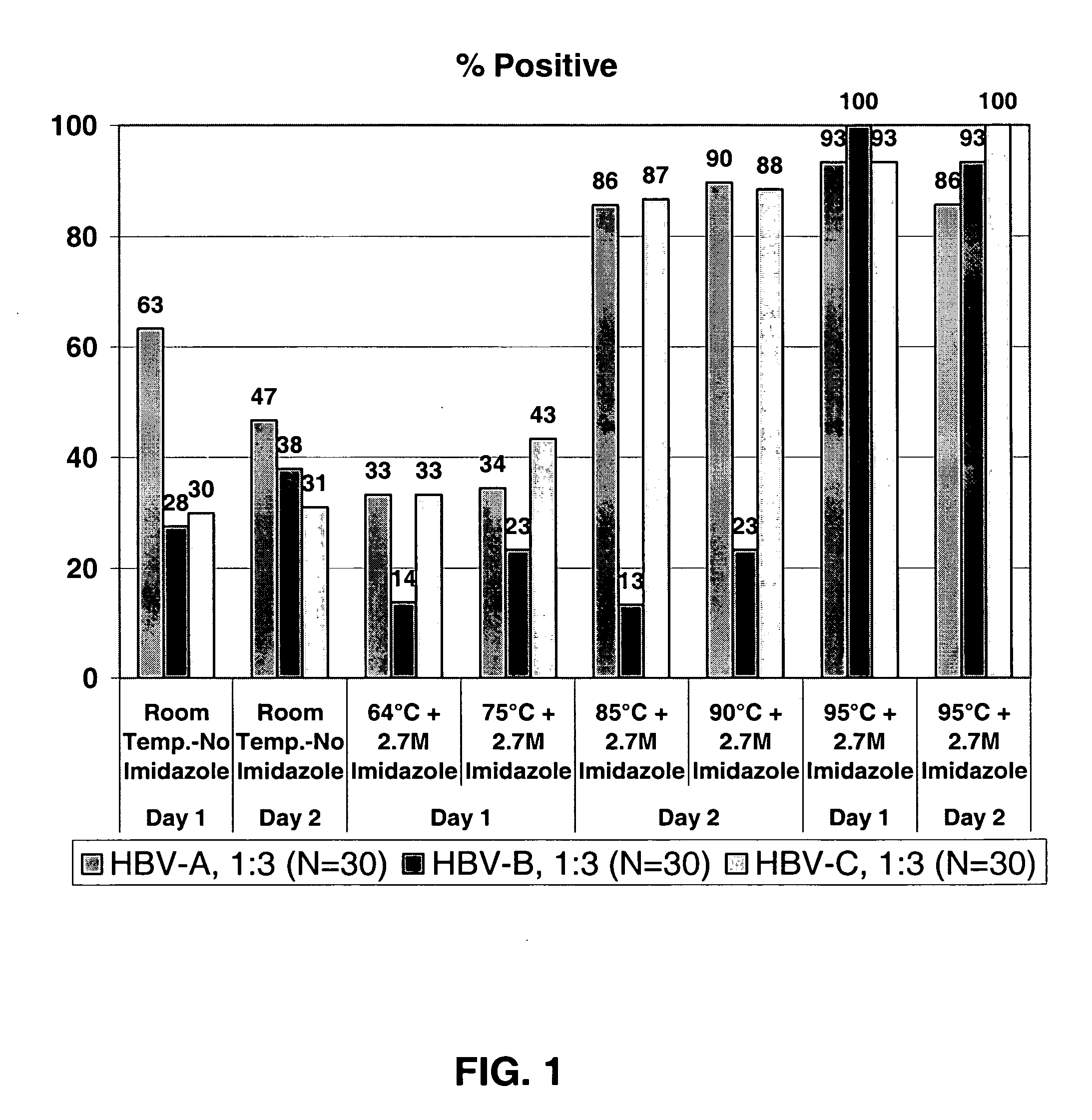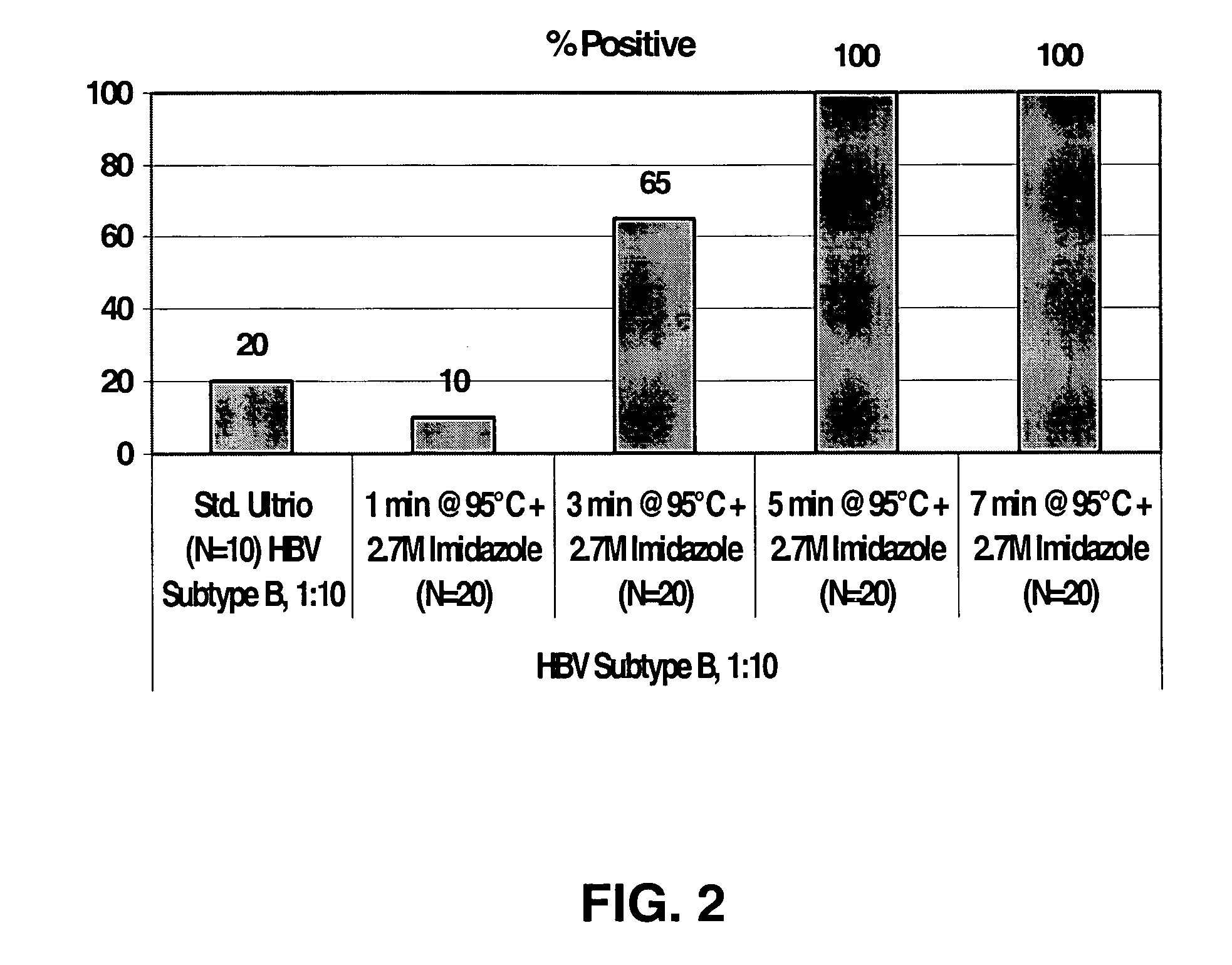Methods of nucleic acid target capture
a nucleic acid target and capture method technology, applied in the field of molecular biology, can solve the problems of long time-consuming and labor-intensive isolating methods, complicated procedures, harsh chemicals,
- Summary
- Abstract
- Description
- Claims
- Application Information
AI Technical Summary
Problems solved by technology
Method used
Image
Examples
example 1
Target Capture of RNA Known to Have Secondary and Tertiary Structure
[0042] This example demonstrates that hybridization conditions that include imidazole generally increased efficiency and kinetics of target capture of a RNA known to have secondary and tertiary structure (23S rRNA) at relatively low incubation temperatures, e.g., RT to about 42° C. for many capture probes. Secondary and / or tertiary structure in the target RNA may inhibit interaction with a capture probe and limit target capture. Experiments were performed by using a known amount of Chlamydia trachomatis 23S rRNA which was hybridized to a labeled detection probe complementary to a sequence in the rRNA to label the target RNA before it was captured. Typically, 200 fmole of 23S rRNA was hybridized with 1 pmole of an AE-labeled synthetic oligonucleotide in hybridization reagent (60° C. for 30 min, followed by cooling to RT). An aliquot of the hybridized detection probe:target mixture was mixed with target capture reage...
example 2
Target Capture of a Synthetic Target Present in a Partially Double-Stranded DNA
[0046] This example demonstrates efficiencies of target capture when the reaction mixtures contained different concentrations of imidazole, all incubated at 60° C. for 15 min, followed by incubation at RT for 30 min. For these tests, a partially double-stranded DNA (dsDNA) was made by synthesizing a strand of SEQ ID NO:1 and its complementary strand (SEQ ID NO:2), hybridizing the two strands together (35 pmol of each in 20 μl of hybridization reagent (P-type), incubated at 60° C. for 1 hr, and cooled to RT). The resultant dsDNA contained, at one end, a 30 nt single-stranded DNA that is complementary to a detection probe (SEQ ID NO:4). Each target capture reaction mixture contained 10 fmoles of dsDNA target in 0.2 ml of sample transport reagent to which was added 0.2 ml of target capture reagent (TCR, C-type) containing 0 to 3.18 M imidazole, 0.1 ml of TCR containing 50 μg of paramagnetic particles (Sera-...
example 3
Target Capture of a Target Strand Present in Synthetic dsDNA
[0048] Additional tests were performed using conditions substantially as described in Example 2, but using different synthetic versions of the capture probe that contained LNA or DNA residues in the 5′ target-specific region (nt 1-25 of SEQ ID NO:3). Each target capture reaction included 20 fmoles of the dsDNA target in 0.2 ml of sample transport reagent to which was added 0.2 ml of TCR (C-type) containing from 0 to 4.2 M imidazole, 0.1 ml of TCR containing 50 μg of magnetic particles (Sera-Mag™) with covalently attached dT14 oligomers, and 20 pmoles of capture probe that contained LNA or DNA residues in the 5′ target-specific sequence. Reactions were incubated at 60° C. for 15 min, then at RT for 30 min, and treated as described above for capture, washing, and detection steps. Controls were treated similarly but contained no target (background control) or contained no capture probe (net RLU: 92). Results of these tests ar...
PUM
| Property | Measurement | Unit |
|---|---|---|
| temperature | aaaaa | aaaaa |
| temperature | aaaaa | aaaaa |
| temperature | aaaaa | aaaaa |
Abstract
Description
Claims
Application Information
 Login to View More
Login to View More - R&D
- Intellectual Property
- Life Sciences
- Materials
- Tech Scout
- Unparalleled Data Quality
- Higher Quality Content
- 60% Fewer Hallucinations
Browse by: Latest US Patents, China's latest patents, Technical Efficacy Thesaurus, Application Domain, Technology Topic, Popular Technical Reports.
© 2025 PatSnap. All rights reserved.Legal|Privacy policy|Modern Slavery Act Transparency Statement|Sitemap|About US| Contact US: help@patsnap.com


